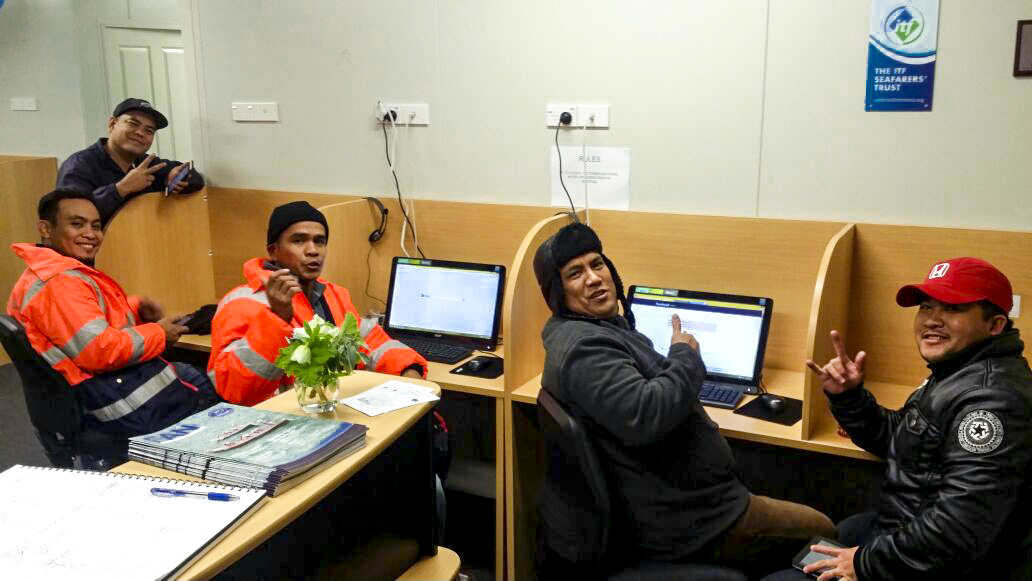You are here
Digitalization and Ship Connectivity in 2018: Newcomer seafarers will be digital natives speaking English, comforable with Python, Java programming languages
Digitalization and Ship Connectivity in 2018
Stephen Conley 2018-01-20 https://www.maritime-executive.com/blog/digitalization-and-ship-connecti...
Lyttelton Seafarers’ Centre in Lyttelton provides free internet access so seafarers
While vessels will continue to slow steam in the face of challenging freight rates and volatile bunker prices, the rapid growth of digitalization is challenging traditional ship operating practices, and changing the roles and responsibilities of the shipping industry’s 1.5 million seafarers dramatically.
Re-thinking the role of the seafarer
Last year, ICS and BIMCO projected that shipping would need nearly 150,000 more sailors by 2025 to meet the current anticipated demand growth. Much has changed in the last 12 months, but the need for crew hasn’t become any less acute. Almost all of these newcomers will be digital natives who have been brought up with digital technology and are familiar with its capabilities. Their common language is likely to remain English, but many of them will be equally comfortable in computer programming languages, such as Python or Java. Similarly, the roles and responsibilities of a chief engineer in 2020 are likely to be broadly similar to their current daily duties.
However, as ships become more digitized and depend upon data connectivity to function at their fullest, it will take crew that are fully versed in the latest technologies to maximize their vessel’s operational potential.
At first glance, it might seem like smart ships and automation are the simple answer to seafarer shortages. I don’t believe this to be the case. But even if it is, we’re some years away from that being reality.
Shipowners who have endured the last decade’s challenging freight rates and global instability need solutions that can deliver immediately.
Realising increased safety, welfare, efficiency and timely operations
Guaranteeing that seafarers’ rights under the Maritime Labour Convention 2006 – in particular access to communications by ship’s crew – are fully adhered should be a given. So when it comes to recruitment, more fundamental questions need to be asked. What kind of seafarers are we trying to recruit? What do sailors of that caliber expect on board? Can we provide them with lifestyles that are similar to the ones they can enjoy ashore?
Much of that - from the training that’s the bedrock of career growth to Skyping loved ones from the middle of the Atlantic - can be achieved via the provision of reliable, high performance and cost-effective data services.
Investments to make this a reality for mariners often pay dividends in unexpected ways. I’ve spoken to a number of operators this year who brought internet aboard for their crews in the early part of this decade as they sought to ensure a better quality of crew.
The improvements they’ve seen in morale, reduced social isolation, and improved crew retention were expected in large part. What really surprised them was how well positioned this had left them for the data-enabled services that have become vital to the efficient operation of their ships today. Already many of them are now taking the lessons they learned from those experiences and the competitive advantages they gained, and using them to project future capacity requirements.
They understand that shipping’s digital transformation is well under way, exponential data growth is now the norm, and that they need to scale their connectivity accordingly.
Empowering the global shipping industry with always-on connectivity
But connectivity needs to be reliable, always available and ensure high speed throughput both on vessels and onshore. As the only provider in the industry to offer multi-orbit (GEO and MEO) satellite-enabled connectivity solutions in multiple bands (Ka-, Ku- and C-band), SES Networks can flexibly deliver the capacity that ship owners, operators and seafarers need to make better informed commercial decisions, and enable them to remain competitive in an increasingly challenging and commoditized marketplace.
Additionally, new service innovations, such as SES Networks’ Maritime+ solution, are making VSAT networks simpler to use, more cost efficient, and more powerful. This drives even bigger ROI for owners and operators through simple, straightforward access to customizable bandwidth and tailored service level agreements and scalable throughput options, and standardized pricing regardless of region or season of operation.
The 2020s will be shipping’s first fully data-enabled decade. Almost every form of communications from a ship – wherever it is in the world – already travels via satellite for some part of its journey. In the years to come the volume, variety, and velocity of data will increase stratospherically. Indeed, DNV GL now estimates that, in two years, the data capacity of the VSAT network has increased from 8.7 Gbps (Gigabits per second) to 16.5 Gbps – nearly doubling. If this trend continues – and there’s no reason to think it won’t – this capacity will reach 217 Gbps by 2025.
If the next generation of captains and chief engineers are to realize your fleet’s full potential, it will take the provision of reliable, available, and high performing satellite-enabled global managed data services.
Stephen Conley is Maritime Market Segment Lead at SES Networks.

